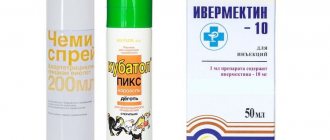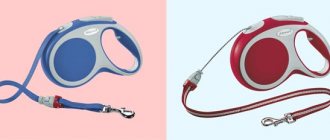Why does tracheitis appear in dogs?
The trachea is a tube consisting of strong cartilaginous rings. Through them, air enters the lungs and exits back. But sometimes the tracheal rings begin to collapse, and when the air escapes, a characteristic buzzing cough occurs. It is difficult to answer exactly why some dogs begin to break down these rings.
But there are a number of reasons that contribute to this:
- feeding cold food from the refrigerator;
- cold drinking water;
- drafts;
- hypothermia;
- weakened immune system;
- allergic reaction;
- upper respiratory tract infection;
- parasites.
There is an opinion that the predisposition to tracheitis in dogs is genetic. Representatives of dwarf breeds of both sexes are susceptible to it. Moreover, Yorkies suffer more than others. The disease can manifest itself at any age, although the average age of patients in veterinary clinics is 6-7 years.
Hypothermia
You can become hypothermic by being exposed to heavy rain or staying in a cold room for a long time. But this is not the only problem. Older pets (after 7 years) do not tolerate weather changes in the fall. Their chronic bronchitis worsens. They are also more likely to be stressed, so they also get sick more often. Hairless pets run the risk of hypothermia even during a normal walk. To prevent this, winter clothes are bought for them.
Important! A foreign body in the respiratory tract or abnormal development of the trachea can provoke the development of bronchitis.
Infections
Infectious tracheitis is secondary to viral and bacterial respiratory tract infections. Another important cause of the disease is parasitic infection.
Infection occurs:
- nematodes (Oslerus osleri, Crenosoma vulpis);
- roundworms (Capillaria aerophila);
- lung helminths (Aelurostrongylus abstrusus).
Conditions of detention
Tracheitis in dogs is secondary to diseases of the oropharynx, cardiac cough, and lung diseases. Other causes include inhalation of smoke and chemical fumes, and an allergic reaction to dust, pollen or other allergens.
Diseases of fungal origin are difficult to tolerate. They are difficult to identify and quite difficult to treat. If you do not start doing this on time, the disease will be complicated by pneumonia or pneumonia.
Prevention measures
To protect your dog as much as possible from inflammation of the trachea and other problems with the respiratory system, you must:
- protect contacts with stray and sick animals;
- wash your paws after a walk in the traditional way or using a special device - a paw wash;
- do not overcool your pet, do not walk in rainy weather;
- avoid drafts;
- Get age-appropriate vaccinations in a timely manner, remove worms from your dog, and treat against fleas, lice, lice, ticks and other parasites;
- provide a complete, balanced diet.
Tracheitis in dogs is a dangerous disease that animals endure quite hard. If treatment is not started in time, the disease can cause more serious problems, including pneumonia. It is important to immediately pay attention to the first signs of violations and contact a specialist for qualified help.
Tracheitis in dogs is characterized by an inflammatory process on the mucous membrane of the trachea. The reasons are poor nutrition and conditions in which the pet is kept. How does the pathology manifest itself and how to treat it? The answer is in the next video:
Useful materials:
- Medium-sized dogs Australian Shepherd or Aussie Australian Cattle Dog or Australian Heeler Australian Kelpie Austrian Hound American…
- Dog with a haircut Our wonderful pets need not only our love, but also care. So that the dog...
- Toy Terrier Dog Features of Terriers Terriers have traditionally been used as hunting and guard dogs. They are known for their excitement, pursuit and...
- The dog ate the puppy Sadly, some bitches after giving birth begin to eat their puppies. Faced with this...
How to determine the disease
Tracheitis in a dog is characterized by the presence of a cough in the absence of concomitant respiratory tract disease.
He:
- strong;
- frequent;
- with a dull sound;
- hysterical.
On auscultation, breath sounds may be weak. But in the advanced stage of the disease, wheezing is heard when inhaling and exhaling. The second significant symptom is coughing cramps.
They are the most significant:
- after rest;
- before active training;
- and intensify with changing weather conditions.
Body temperature may be slightly increased. The dog becomes apathetic, lethargic, and may lose its appetite. The nose is warm and moist. Later it becomes dry. Thick mucus may be discharged from the nostrils.
Did you know? English greyhound
—
The Greyhound is one of the most ancient dog breeds. Its name was formed due to a translator's mistake from the early German language of the word Greishund, which meant “old”, and not gray, as you might think.
Main symptoms
The first and most noticeable symptom of tracheitis is a cough. It is usually strong, dry and hysterical, very weakening the dog. A sick animal becomes lethargic, sleepy and inactive. His body temperature rises, wheezing and hissing when breathing, shortness of breath, and loss of appetite.
The dog mostly lies down without reacting to people, but can sometimes show signs of irritation and even aggression if he is bored.
Treatment of tracheitis in dogs at home
Tracheitis in a dog causes a severe but unproductive dry cough.
As long as there is no fever or signs of an infectious disease, the disease is treated with:
- additional water intake;
- cough syrups;
- recreation.
You can do this at home. The treatment prognosis is favorable. For tracheobronchitis with severe cough and sputum, antibiotics will be prescribed. The choice of drugs for treatment will depend on the pathogen identified. There are also additional nuances. In obese animals, weight loss may be necessary to reduce the effort required to breathe. In this case, treatment will be combined with a diet for weight loss.
Drugs
Drug prescriptions vary depending on the severity and duration of the disease. Bacterial infections are treated with antibiotics. There is no specific treatment for viruses, so symptomatic treatment is used. If there is an underlying disease of the heart, lungs, or tracheal injury, then it is treated, and concomitant diseases are treated symptomatically. In mild and acute cases, maintenance therapy should be effective.
The following drugs are used for therapeutic purposes:
- corticosteroids are the basis for reducing inflammation of the respiratory tract - Prednisolone, Dexamethasone, Methylprednisolone;
- antimicrobial therapy is used to treat infections - Amoxicillin, Betamox, Ciprovet;
- a persistent cough is controlled by antitussive drugs that contain codeine - Hydrocodone, Butorphanol.
Oral corticosteroids "Prednisolone" and "Dexamethasone" or inhaled ones ("Fluticasone", "Budesonide") are indicated for the treatment of asthma, which may accompany tracheitis. Bronchodilators (Albuterol, Terbutaline) can be used as additional therapy in combination with glucocorticoids. Antibiotics are usually not needed except in severe chronic cases. The drug is selected based on the analysis of bacterial cultures obtained during bronchoscopy or other tests.
Important! Treatment of tracheitis is prescribed by the doctor based on the results of the examination, since the causes may be different. Therefore, you cannot self-prescribe medications.
How to treat complications
Complications from tracheitis will concern damage to neighboring organs, which will also become inflamed.
For treatment, the doctor will use the following groups of drugs:
- nitrofurans have a bacteriostatic effect - “Furacilin”, “Furazolidone”, “Furagin”, “Furazonal”, “Furazolin”;
- sulfonamides suppress the activity of bacteria - “Streptotsid”, “Sulfasin”, “Sulfalen”;
- antibiotics - Amoxiclav, Amoxicillin, Gentamicin, Tetracycline, Doxycycline, Erythromycin, Azithromycin;
Supportive vitamin complexes will be prescribed. This could be "Gamavit" or "Glycopin".
How to treat a chronic form of the disease
The chronic form of tracheitis develops against the background of an untreated underlying disease. For example, helminths or inflammation. Therefore, it is treated with the same drugs as the initial phase of the disease.
Main groups of drugs:
- antihistamines to relieve swelling of the mucous membrane - “Suprastin”, “Diphenhydramine”, “Zirtek”;
- mucolytics for cough - "Mukaltin" 1 tablet. for every 10 kg; "Libexin" - 25–50 mg;
- expectorants - a decoction of licorice or coltsfoot; 1 tbsp. A spoonful of leaves is boiled for 1 minute in 200 ml of water, and then diluted with boiled water in a ratio of 1:10 and given instead of drinking.
Did you know? The dog almost does not see a person who is standing at a distance of 280
–3
00 m, but can recognize the owner, who is standing 1500 m away and waving at her.
Care and nutrition during treatment
The dog's diet will consist of slimy cereals (rice, oatmeal) and lean meat. It needs to be crushed. Food should be warm, no higher than +38°C. Be sure to add boiled vegetables to the porridge - carrots, pumpkin.
Folk remedies
The expectorant medications your pet needs are herbal infusions. They thin out thick mucus in the bronchi and facilitate its release. The most famous herb is licorice root. It is produced in syrup form, but you can buy dry powder. The product coats the walls of the trachea, reduces irritation and improves the dog’s well-being. The standard dosage of syrup is 5–10 mg per day. It can be poured into the mouth from a syringe or diluted in a drink.
Infusions of the following herbs are also prepared:
- coltsfoot;
- anise fruit;
- plantain leaves;
- Thermopsis lanceolata herb.
Prepare a drink from clean boiled water and 1 tbsp. spoons of vegetable raw materials. Pour boiling water over the grass, wait about 20 minutes, then strain, cool, dilute to 1 liter with clean boiled water and give to the dog.
Find out in more detail what dogs can get sick with: infectious, parasitic and other diseases.
How can you help an animal?
If you notice any warning signs, you should seek help from a qualified veterinarian. The diagnosis is made based on examination. If necessary, an x-ray is prescribed. If the dog cannot breathe, a hole is made in the trachea. After this, the specialist prescribes treatment.
If your dog is having trouble breathing, take him to the veterinarian.
Advice. You should not begin treating your dog without consulting your veterinarian.
Otherwise, the clinical picture will only worsen. If necessary, a veterinarian should be called to the house.
During the treatment period, the dog is placed in a warm room. It is recommended to limit walking time, especially in the cold season. It is advisable not to walk sick Yorkshire terriers and other small dogs at all.
Drug therapy
If the pathological process is uncomplicated, the dog is prescribed the following:
- antihistamines;
- mucolytic medications;
- antitussive drugs;
- expectorants.
The most effective antihistamine is Diazolin. Of the mucolytics, Mucaltin and Bromhexine help best. Libexin is considered the best antitussive drug. The most effective expectorant drug is Sodium bicarbonate.
In case of complications
If tracheitis is very severe, the veterinarian prescribes the following:
- Nitrofuran derivatives.
- Sulfonamides.
- Antibiotic drugs.
- Antimicrobial drugs.
To treat tracheitis, antibiotics, sulfonamides and other drugs are used.
When prescribing these medications, the veterinarian undertakes to identify contraindications and take them into account.
At the same time, it is recommended to use multivitamin and vitamin preparations (Gamavit, Glycopin, etc.).
Nonspecific resistance of the canine body can be increased by introducing nonspecific or specific serum.
In case of chronicity
If a dog is diagnosed with chronic tracheitis, the doctor undertakes to identify the causative agent. Often the chronic form of this pathology progresses against the background of helminthiasis. If the animal is affected by worms, it is recommended to remove them first. After this, the veterinarian begins treatment of chronic tracheitis.
If the root cause of chronic tracheitis is a neoplasm, then only surgical intervention can help.











